Introduction
Petra Jordan is a remarkable site burdened with false attributions. Wikipedia says it was created by Greeks and Romans. "One of the main things that Petra is known for is its Hellenistic architecture." Unfortunately for Wikipedia, Greeks and Romans had nothing to do with Petra nor did anyone else within the historic-time-frame. This article will present evidence to sustain this assertion. Petra is going to bring down a bunch of cherished historic narratives.
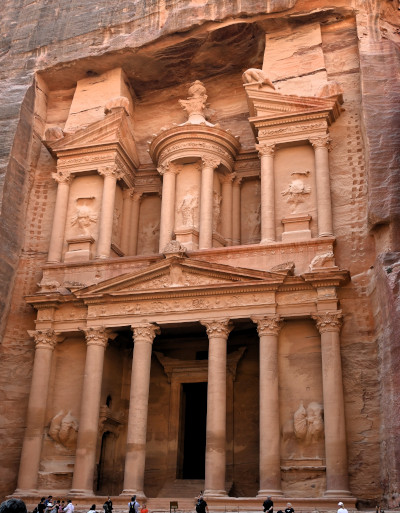
Petra's construction has features that distinguish it from Hellenistic architecture. In order to build a structure like the above, a culture has to have technical skills for unilithic construction, i.e., hewn from bedrock. Neither Greeks nor Romans built in this manner. Its monumental size is another similarity to Antecedent Egypt rather than Greece or Rome. Only Antecedent monolithic columns taken from Egypt and affixed to the Pantheon's portico allowed it to achieve majestic countenance. Egyptian temples had massive pylons whereas Petra used impressive facades. Egyptians used great quantities of very large blocks to create their monuments. That option was not available here, so the builders carved bedrock on a monumental scale. The narratives use an apparent similarity to gloss over disruptive dissimilarity. For example, Petra's architecture looks Hellenistic, but unilithic construction and massive quarrying can not be explained using the Hellenistic narrative. These differences are ignored. These, however, are minor debatable details. What can not be questioned is on the facade below and others at Petra.
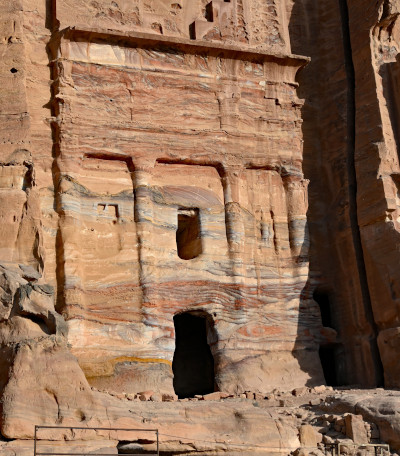
On the left side of fig.2, a powerful bolt of electricity struck. The damage is obvious. Bolts of this magnitude can only originate from z-pinch aurora (ZPA), but they do not have fracturing associated with Sipsey Event (SE). Sardinians recorded, in Domus de Janas, appearances of z-pinches, but dating on Sardinia is difficult. Researchers report a dust event of irregular spatial dimensions occurred between 2400-2100BC in the Middle East.1 Only Peratt Events2 could generate the required dust 'with great spatial variability'. That was the last possible date that could be associated with their appearance in the Middle East. These events were accompanied by powerful bolts of electricity. The 2100BC time period removed the Greek and Romans from the scene. Petra was a key source of luxury products from Arabia, so as traders, Greeks were present in the city. If ZPA struck the Middle East in the first century BC or after, it would have been recorded just as the demise of Pompey was in 79AD. It is impossible for a large swath of the Middle East to suffer devastation by the ZPA and escape notice. Especially with the concomitant disruption of trade between Rome and Petra. The Greeks and Arabs found it in the current state of preservation. Therefore, the only actors who could have created Petra were Antecedents. This moves Petra's construction back beyond ten thousand years.
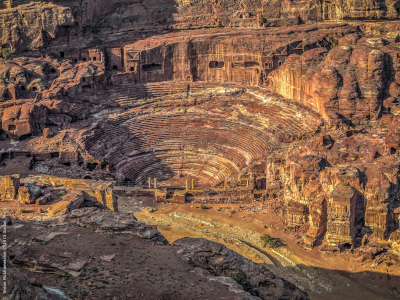
The above image brings down another domino. The theater at Petra has been attributed to Greeks or Romans. However, they had nothing to do with it. A point obvious just from massive quarrying done to complete the theater. It was an Antecedent project. An entire hillside was cut away to level the area in preparation for construction. On the Giza plateau, the same was done when huge stone blocks, from 100 to 400 tons, were removed in preparation for pyramid construction. From that point, builders cut downward hewing seats out the bedrock as they progressed. Greeks, on the other hand, shaped their theaters around naturally sloping land and used blocks to create seating. Narratives grossly distort what Greeks or Romans were capable of accomplishing. The theater demonstrated Petra was wealthy enough to afford such an expensive civic ornament.
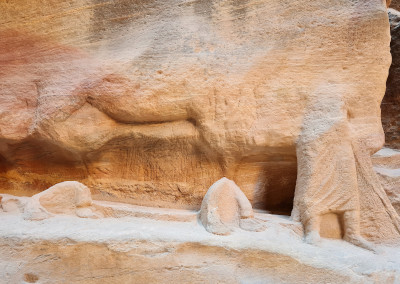
Image above topples another domino. While the camel suffered severe plasma erosion, it can be identified by the feet. Erosion dated camels as beasts of burden prior to the Pleistocene Catastrophe (PC)3. Humans domesticated animals like camels and horses tens of thousands years ago. The wealth of Pre-PC Petra was derived from the same source as first century Petra, trade with the Arabian Peninsula. Ornate facades and theater indicated great wealth resided in the city. This carving might have been a tribute to those merchants and their camels who converged on the city with merchandise. Facades may have represented private trading houses where merchandise was stored.
A high profit product was required to pay for massive construction found at Petra. The product was myrrh and frankincense. Petra performed the same role in the tenth millennium BC as it did in the first century AD. Much of the incense bound for the Mediterranean markets passed through the city. There is no reason to believe myrrh and frankincense did not command the same high prices in the very distance past as it did during the historic-time-frame. Southern Arabia is the source of these products, because they are not easily produced anywhere else in the world. In Yemen were found stone storerooms built in the cliff face with sufficient storage to contain an entire summer's harvest4. The storage spaces comprised over a thousand square feet each, and they were not hollowed out with hammer and chisel. It was the same people as in 1 AD just the epoch differed.
Like Antecedent Egypt, Petra Antecedents carved structures on a monumental scale, fig.5-6. The entire cliffs were cut away. When completed, the face would have been smooth without pits and cavities evident today. The only way these structures could have been carved was from top down and not without considerable planning. As the quarrying proceeded down the cliff face, the facades were carved. Egypt showed that Antecedents, using plasma technology, quarried on an industrial scale.5. Builders of Petra used the same industrialize construction. No one else could have founded a city in the middle of a desert. These were not hammer and chisel people.
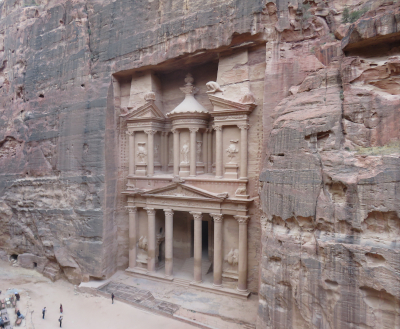
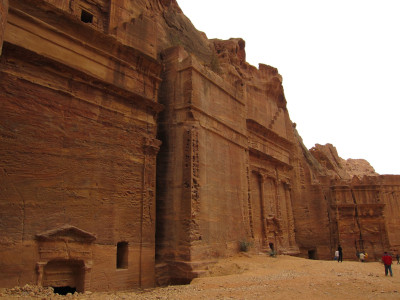
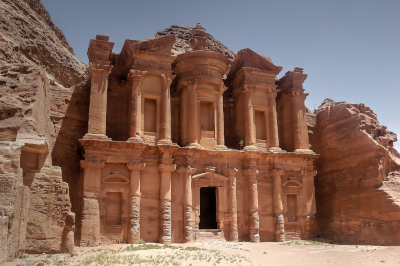
The above image addresses the nebulous 'weathering' notion. Damage like this is always attributed to the elements. Weathering is an extraordinarily slow process that can only be proven by reference. A walk through any cemetery with poor quality marble tombstones that have been in place over a century will show signs of weathering. So, as a notion it is 'taken for granted' any deterioration is due to weather. But weathering is not like ice, one does not have to prove ice is cold, that property is understood. While this type of erosion is thrown into the weathering category, it does not fit that narrative. Damage to structures at Petra is both random and precise. This is seen in a line of downward trending damage on the bottom row of columns, fig.7, yet immediately above the line stone looks as it did when the workmen finished. Only plasma exhibits such precision in nature, yet plasma's behaviors is a mystery. Only by comparing what occurred on Sardinia where they were witnessed and recorded with what is seen elsewhere, can these events be understood.

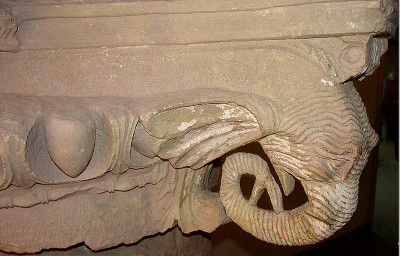
When viewing images of Egyptian pyramids, one is struck by the near complete lack a plasma erosion on major pyramids. This can not be attributed to the lack of casing stones, because enough of it remained to provide a palette. Image above, fig.8, exhibits the same phenomena. Middle two pyramids were clipped off at the top, but plasma only got a grip on the far right. While the lower portion if the facade suffered severe plasma erosion, the pyramids were spared. Was it due to the gap between each, or did their shape offer partial immunity? Petra is a study in plasma behavior.
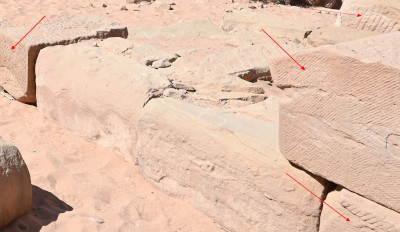
The image above is more evidence of Antecedent technology in Petra. Red arrows point to the plasma extraction patterns like those at Silsila Quarry.6 Apparently technology used at Petra was more advanced than the Egyptian version. Extraction channels were either broad and narrow. The two different patterns can be seen on the left side of image. In Egypt, they proved their mastery of industrial scale stone quarrying. The same was done at Petra. Facades were carved from the top down, and the quarrying was on a massive scale. Their source of energy for this work is a mystery. The terrain around Petra did not lend itself to monumental block construction like Egypt, so Petra Antecedents used unilithic construction to create architectural masterpieces.
Current view of Petra is the product of unproven narratives. Greeks and Romans had nothing to do with the city's construction. They were hammer and chisel people. To assert Petra was created by low tech means is a Fantasyland notion without cartoon characters. Rome's Colosseum was built block by block up not down into bedrock. Petra, like the iconic statues and temples of Egypt, was inherited from Antecedents. The historic population just moved in, and used it as a ready-made trading center. Its architectural accomplishments showed Antecedent civilization were wealthy, technically advanced and spread across the Mediterranean. Only trade could fund Petra's massive construction. Surrounding land was too barren for anything else. ZPA had always constrained Antecedent technological progress because of metal's high venerability to plasma. Modern civilizations have yet to confront that restriction.
The impact of electrical strikes at Sipsey, Al or the ice wedges in the Arctic present a sanitized impression of ZPA's power because of obscurity or remoteness. There is, however, nothing sanitized about devastation at Petra. Almost all facades suffered severe plasma and electrical damage. High canyon walls probably absorbed much of the energy descending from the ZPA. Without them, the place would probably resemble the Bubastis debris field. Across the Mediterranean abundant evidence proclaims the narratives are nonsense. They, like the ventriloquist's puppet, are scripted acts. It does not take any imagination to envision what would happen if ZPA carved zp-prints through an American city. There is a profound lack of courage and sense of duty to confront the shaman fantasies like 'weathering', 'hunter-gatherers', 'cavemen', pounders, etc. and address evidence. Vacuous notions like these have produced repeaters not thinkers. Requirement for supporting evidence has not been repealed. It still counts. The z-pinches are coming back, and Petra and Egypt are cold reality of their devastating impact.
-
The Soil Record of an Exceptional Event at 4000 BP in the Middle East, Marie-Agnes Courty, article: While the author has backed out the article's conclusion, the factual evidence is being quoted here.↩︎
-
Peratt Events were the plasma connection between Earth and ZPA. See 'Why Nuraghi Were Built'.↩︎
-
The disaster that swiped out the Megafauna.↩︎
-
The Roman Empire and the Indian Ocean, Raoul McLaughlin, Pen & Sword Books Ltd, 2014. pg. 140.↩︎
-
Antecedents industrialized quarrying was the only reason for the city's existence. A very sophisticated water management system was built at Petra but is not covered here.↩︎
-
On close inspection plasma extractions patterns can be seen on some ruins across the Middle East.↩︎

